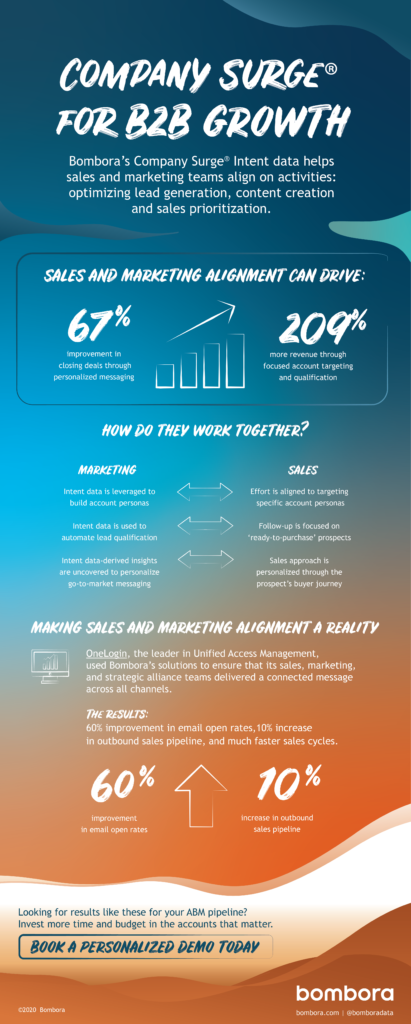B2B Intent data explained: 4 ways you can strengthen marketing and sales team alignment
The B2B marketing and sales team divide is a cliché adage in Account-Based Marketing (ABM), but getting them to work in concert is a vital step in scaling top-line growth and increasing ROI.
The two teams might be a part of the same enterprise, but are often chasing different metrics and speaking in terms the other side doesn’t understand. That’s where the value of Intent data comes in.
For instance:
- Teams could close more deals in less time and move prospects through the sales funnel with personalized B2B marketing campaigns.
- They could become more effective at outreach tactics and as a result, shorten the sales cycle timeline.
- Sales and marketing alignment can help sales development representatives (SDRs) become 67% better at closing deals and generate 209% more revenue from marketing operations.
However, both departments have to speak the ‘same lingo’ for this to work, which is where Intent data can be a critical tool for pursuing effective go-to-market results. By revealing topics and product categories prospects are interested in, it can act as a bridge over which marketing and sales consistently collaborate. Depending on how you choose to use it, Intent data can help teams align their actions in more ways than one.
1. Jointly building target accounts and buyer personas
Teams can use Intent data-derived insights to collaboratively build detailed profiles of target accounts. This cooperation would allow everyone to gain visibility around the rationale for approaching specific prospect segments and showcasing the unique selling points (USPs) most relevant to their needs.
Intent data can also help B2B marketers and sales reps create a more complete picture of buyer personas within those target accounts. It would ensure that your teams target the same persona, with the right message, at the most ideal point in time during their target leads’ research process. The increased alignment would enable marketing to deliver leads that your sales team actually wants to pursue, leading to more engagement, acute sales intelligence, and an increased focus on the accounts that matter the most.
2. Less friction in lead generation and distribution
Producing leads is just the tip of the iceberg when it comes to building a growth engine for your ABM pipeline. Those same leads need to be qualified and assigned to the right SDR or team lead. Ideally, you would want to automate that flow of information, and that’s where Intent data can save you some time. Depending on their propensity to buy, leads can either be forwarded to sales or put into email drip campaigns for nurturing.
This methodology also reduces lead quality discussions. Marketers would have accurate data-based tools to identify accounts that are in-market and likely to buy, while sales teams would receive a steady stream of qualified prospects. By having an automated system in place to distribute leads, businesses could act with agility on the most qualified sales opportunities.
Monitoring the existing customers gets easier, too. Intent data reveals which of your clients are researching competitors or looking for additional solutions that you offer but haven’t sold them yet. The sales team could rapidly act on this information and prevent customers from leaving and going towards your competitors.
3. Personalize messaging and content strategies
Having a list of qualified leads to target is vital for proactively boosting revenue. But it’s equally important to ensure that marketing and sales collaborate on crafting effective go-to-market messaging and positioning. Each team brings unique insights to the table in order to create a 360-view into what prospects want to know about your customers’ experience. They can then use Intent data to direct their efforts around topics and solutions prospects are actively researching to encourage the most ROI-worthy outcomes.
Instead of blasting messages and ads at potential buyers, you’d be able to personalize outreach activities which are hyper-relevant to their needs. Well-orchestrated cooperation of marketing and sales teams would result in more scheduled meetings and a strong impression that your enterprise has THE solution that serves all the prospects’ needs.
Content marketing is another field where Intent data can bring the teams’ goals together. It reveals challenges prospects are researching, and sales reps and marketers can use this data as a starting point to come up with relevant topics to promote. Providing potential buyers with valuable content that tackles their pain points builds both brand and user trust, and makes it easier to convert them to a won lead.
4. Making sales and marketing alignment a reality
Intent data helps sales and B2B marketing teams align their activities instead of operating as distant siloes. It makes it easier to optimize lead generation, content creation, and sales prioritization, resulting in increased revenue and customer loyalty. To learn more about achieving goals like these, sign up for your FREE Intent data report to start exploring how Intent data can work for your sales and marketing teams, and gain access to unique insights about your most valuable prospects today.



